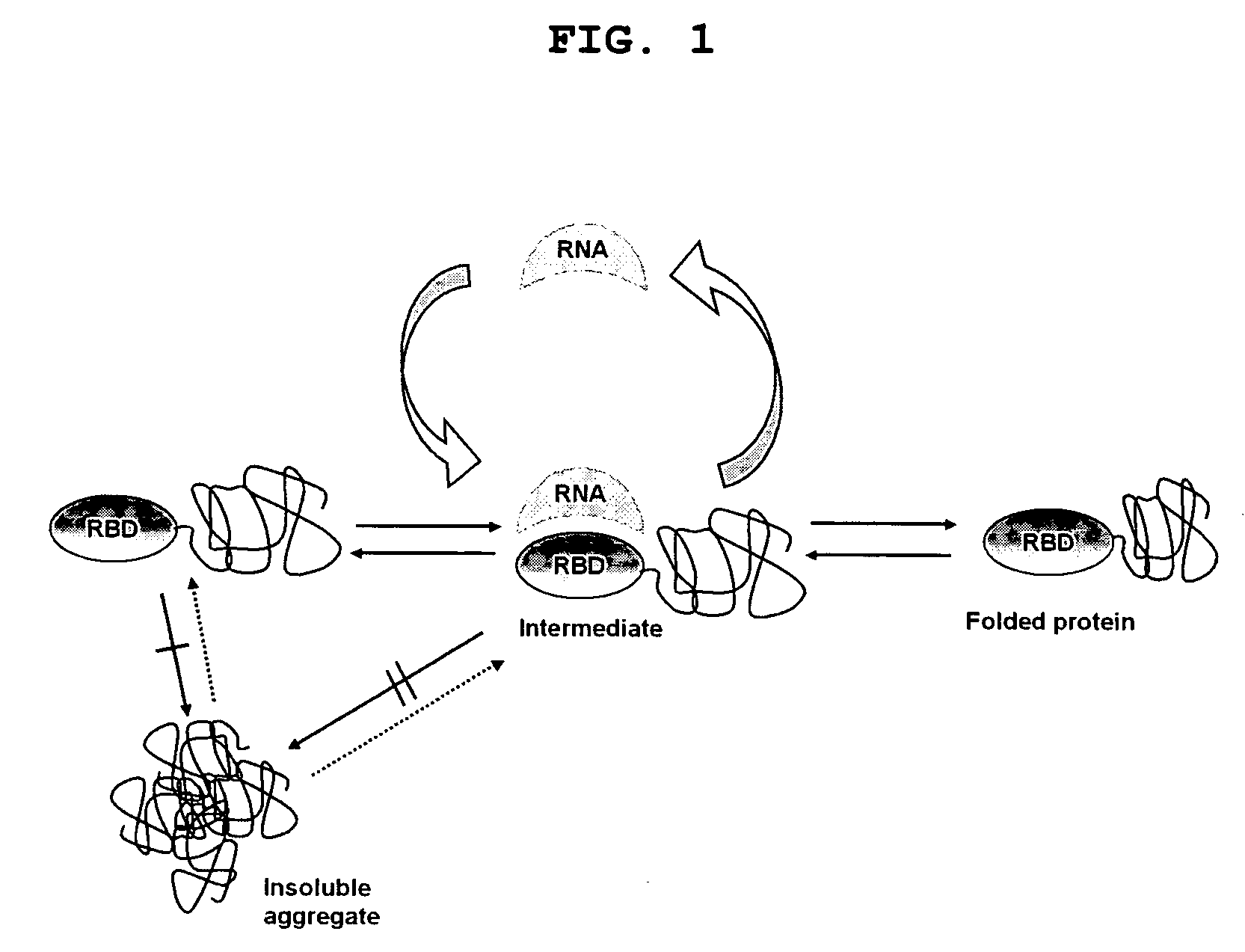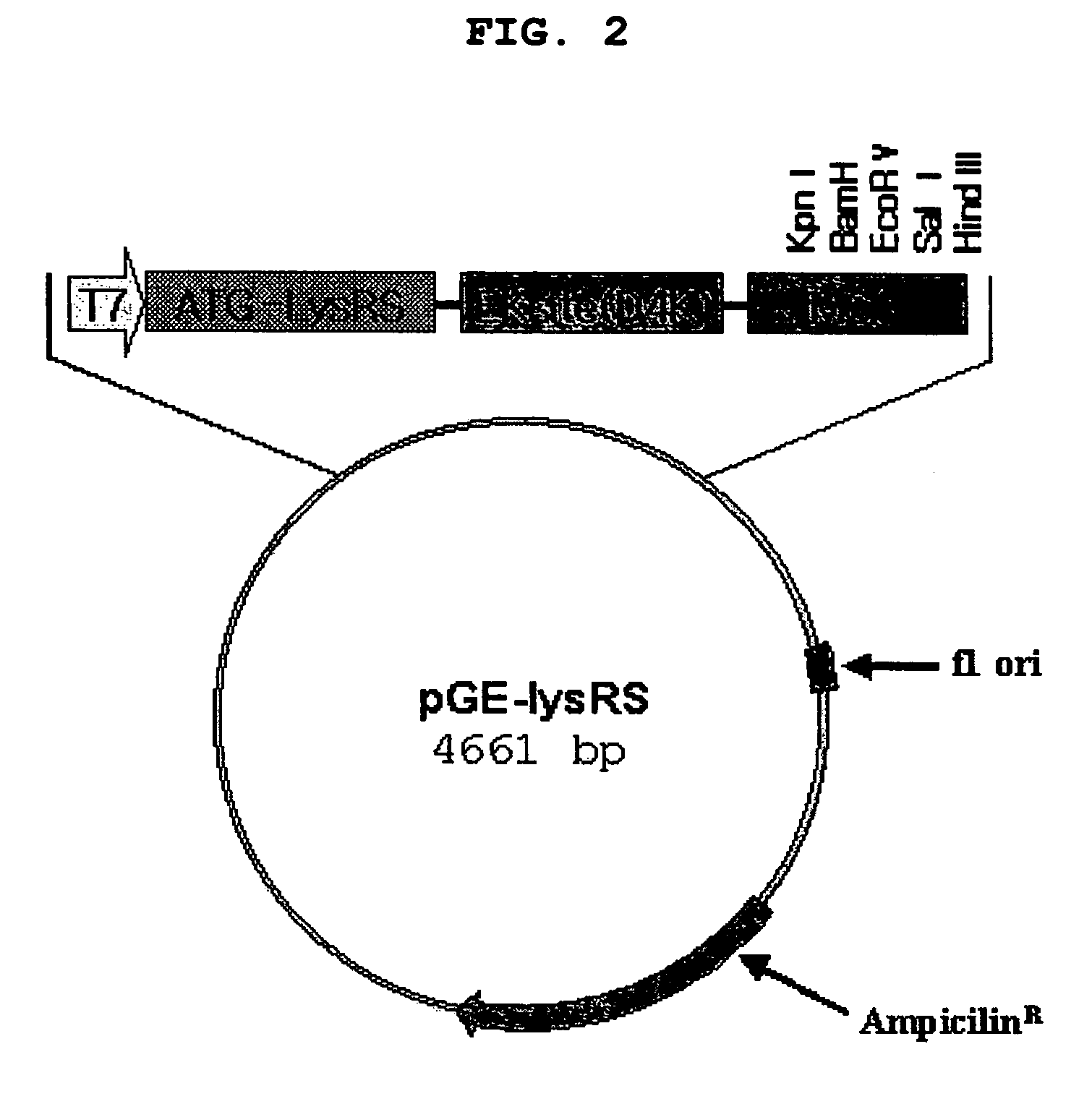Method for improving solubility and folding efficiency of target proteins using RNA as molecular chaperone
a technology of molecular chaperone and target protein, which is applied in the field of improving the solubility and solubility of target proteins, can solve the problems of difficult industrialization of such proteins, difficult to find effective refolding conditions, and inability to have a variety of intracellular elements, etc., and achieve the effect of improving the solubility and solubility of a target protein
- Summary
- Abstract
- Description
- Claims
- Application Information
AI Technical Summary
Benefits of technology
Problems solved by technology
Method used
Image
Examples
example 1
Preparation of Expression Vectors Encoding RNA-Binding Proteins to be Linked to Target Proteins
[0200]Expression vectors expressing RNA-binding proteins to be fused to target proteins forming RNP complexes with tRNA, mRNA or rRNA were constructed. In detail, the following proteins were selected as RNA-binding proteins to link target proteins: E. coli lysyl tRNA synthetase (hereinafter, referred to as “lysRS”), tyrosyl tRNA synthetase (hereinafter, referred to as “tyrRS”), tryptophan tRNA synthetase (hereinafter, referred to as “trpRS”), E. coli rRNA binding proteins S1, S4 and S17, E. coli Hsp 15 and DbpA, Ffh protein of E. coli signal recognition particle (SRP), C5 protein of RNase P and influenza A virus (WSN / 3 / 33) nucleoprotein (NP).
[0201]First, PCR was carried out using genomic DNA obtained from JM109 cells (Gene, 1985, 33, 103-119) as a template and primers designated SEQ ID NO: 1 and SEQ ID NO: 2. The resulting PCR product ‘lysRS’ was cloned to a pGEMEX-ΔNdeI vector, which was ...
example 2
Evaluation of Effect of RNA Binding Domains on the Solubility of a Target Protein
[0203]In order to investigate effect of RNA-binding proteins from various sources on solubility of a target protein, protease of tobacco etch virus (hereinafter, referred to as “TEV”) was used as a target protein, and fused with each RNA-binding protein. In detail, PCR was carried out using pRK793 plasmid (Protein Engineering, 14; 993-1000, 2001) as a template and primers designated SEQ ID NO: 25 and SEQ ID NO: 26. The amplified PCR product was inserted into each of the vectors prepared in Example 1, pGE-lysRS, pGE-Hsp15, pGE-Ffh, pGE-C5, pGE-NP and pGE-MBP. The resulting expression vectors were designated as “plysRS-TEV”, “pHsp15-TEV”, “pFfh-TEV”, “pC5-TEV” and “pNP-TEV”.
[0204]Then, each of the expression vectors was introduced into E. coli HMS174(DE3)plysE (Novagen, USA). Single colonies were inoculated in 2 ml of LB medium containing ampicillin of 50 μg / ml and chloramphenicol of 30 μg / ml, followed by...
example 3
CIP (Controlled Intracellular Processing) of Fusion Proteins with NP-TEV Protease
[0208]To obtain mature proteins of interest, the RNA-binding protein-target fusion protein, after purification from the expression host, must then be treated in vitro with sequence-specific proteases such as enterokinase, thrombin, factor Xa, or TEV protease. However, these procedures are usually time-consuming and labor-intensive. To overcome these problems and simplify the overall process for protein production, we constructed an in vivo cleavage system where the expression of fusion protein and the cleavage by site-specific protease occur simultaneously inside the cell (controlled intra-cellular processing). For this, functionally active TEV protease is expressed by autocatalytic cleavage of RBP-TEV protease at the linker region containing the TEV recognition site. Here, the TEV protease was fused to the C-terminus of NP. The DNA fragments encoding arabinose promoter was obtained by PCR amplification...
PUM
| Property | Measurement | Unit |
|---|---|---|
| temperature | aaaaa | aaaaa |
| temperature | aaaaa | aaaaa |
| volume | aaaaa | aaaaa |
Abstract
Description
Claims
Application Information
 Login to View More
Login to View More - R&D
- Intellectual Property
- Life Sciences
- Materials
- Tech Scout
- Unparalleled Data Quality
- Higher Quality Content
- 60% Fewer Hallucinations
Browse by: Latest US Patents, China's latest patents, Technical Efficacy Thesaurus, Application Domain, Technology Topic, Popular Technical Reports.
© 2025 PatSnap. All rights reserved.Legal|Privacy policy|Modern Slavery Act Transparency Statement|Sitemap|About US| Contact US: help@patsnap.com



